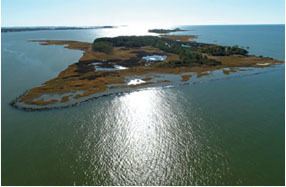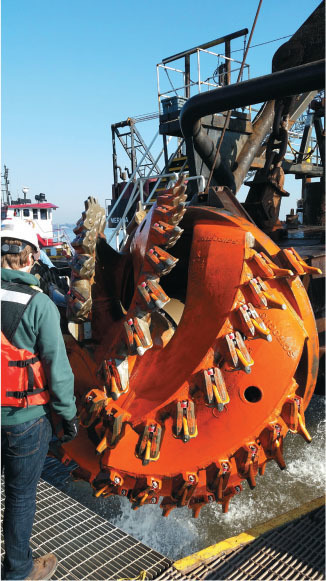
Endangered sea turtle species rarely visit the beaches of South Florida to nest during the cold winter months, which is one of the reasons the Port of Palm Beach finds they are also good months for some serious sand-moving. Plus, the sights and sounds of workers assembling a pipeline and operating machinery on the beach are usually enough to keep sea turtles and seabirds from nesting nearby.
But sometimes, wild animals just can’t take a hint, so the environmental consultants get up early and dutifully make their rounds.
Each morning during the project, environmental consultants will drive all-terrain vehicles up and down those beaches looking for turtle tracks. If nests are found, that area will be marked off with stakes and orange flagging so that sand isn’t deposited there, or the nests will be relocated. Any eggs present will be moved along with the nests or taken to a sea-turtle hatchery. In time, the young turtles may be released back into the wild.
“They’ll be there every morning throughout this project,” said Port Engineer Ronald Coddington.
The dredging project was scheduled to start in January and last for three months, moving about 400,000 cubic yards of sand. Dredging material from the settling basins and harbor channel would be transported by hopper dredge and pumped onto the beaches of the town of Palm Beach, reversing years of erosion – but not at the cost of the local wildlife and environment.
Jene Adler, business development manager and environmental services project coordinator for Texas-based Orion Marine Group, said it’s rare for a sea turtle to be sucked up during hydraulic dredging. Turtles are less likely to swim in the deep waters where dredging takes place at ports, and suction pipes are equipped with screens or other excluder devices to prevent such an occurrence.
But when it does happen, it’s immediately reported to the Corps, as mandated by federal law. Turtles sometimes survive the ordeal, emerging with a bruised shell or missing a limb, and are swiftly transported to a rehabilitation facility, Adler said.
“The Corps of Engineers is very much on top of that,” she said. “There are lots of protocols in place to keep that from happening, so it’s rare, but it does happen.”
Monitoring seabird and sea turtle activity is just one of the ways AAPA members are keeping the environment top of mind during improvement projects. Under the watchful eye of environmental agencies and the U.S. Army Corps of Engineers, which supervises most of the dredging activity in the United States, ports and dredging companies are working hard to be good stewards of the environment.
Keeping the Impact Contained
Since dredging at ports typically is performed in deeper waters, many projects don’t take place amid fisheries or parts of the seafloor inhabited by seagrass or coral, which need clear water and sunlight to thrive, according to William H. Hanson, senior vice president for government relations and business development at Great Lakes Dredge and Dock Co.
Hanson’s company, the nation’s largest provider of dredging services, moved its headquarters to Houston in 2020 from Oak Brook, Ill. Over its 132-year history, GLDD has performed dredging work at just about every major port in the country.
Hanson said a more common issue is that turbidity from dredging operations may deposit sediment on top of seagrass, depriving it of sunlight. Since port channels must be widened as they’re deepened, nearby patches of seagrass and coral may be adversely impacted by turbidity plumes, especially during mechanical dredging operations.
To mitigate that risk, contractors may use a full-depth turbidity curtain, typically made from reinforced, impermeable PVC fabric. The turbidity barrier stretches from the water’s surface to the seafloor to contain the silt and sediment stirred up by dredging.
Transplanting Seagrass and Coral
Manatees, a threatened species of marine mammal, rely on seagrass for food, so when it’s found near a proposed dredging site, it’s often replanted in another area. During PortMiami’s major deepening project that was completed in 2015, CSA Ocean Sciences Inc. transplanted more than 115,000 seagrass plants into a newly filled dredge hole north of the Julia Tuttle Causeway in Miami.
CSA was part of the GLDD team that was awarded the primary contract for the Miami project by the Corps. Divers meticulously planted 29,000 bare-root “planting units” by hand to ensure that the growing tips of the plant were buried to the appropriate depth below the sediment surface. To provide passive fertilization through the introduction of coastal bird feces, more than 1,150 bird roosting stakes were installed within the 17-acre mitigation site, according to CSA.
Two months later, CSA conducted the first monitoring survey to assess the success of the operation. Despite manatees consistently feeding on the seagrass, the survival rate of the planting units was documented at 97.6%, much higher than the mandated 70% rate.
“Barring any unforeseen disturbances, this is on course to be one of the largest and most successful actively planted, commercial [seagrass mitigation]projects to date,” Dr. Mark Fonseca, vice president of science at CSA, said in a statement.
Grassy seafloors also provide ideal habitat for fish and other marine species, so that project serves as a prime example of the beneficial use of dredging material, Hanson said.

“It’s been wildly successful,” he said. “On weekends, that area is just jam-packed with fishing boats.”
Coral reefs, some of the most diverse ecosystems in the world, also are a concern when port channels are widened and when new ship berths or terminals are built. But like seagrass, coral colonies can be transplanted thanks to scientific advances that have made the process somewhat routine.
Take, for example, the Florida Keys National Marine Sanctuary, which removes coral colonies from docks, seawalls and shoreline-stabilization projects, rescuing them from potential damage. Since 2003, approximately 9,500 coral colonies and fragments have been rescued by the sanctuary and its partners during construction and maintenance projects, according to the group.

The sanctuary said larger coral colonies often are transplanted back to the original site or a nearby location with similar habitat after construction has concluded. Some corals are transplanted to depleted reef sites or placed in underwater nurseries to grow and propagate new colonies for reef restoration. Others are shared with public aquariums for educational exhibits or with universities and organizations to conduct research.
“Coral relocation has been somewhat perfected, and many environmental companies have done quite a bit of it,” said the Port of Palm Beach’s Coddington.

Take It to the Mitigation Bank
When dredging operations impact the environment substantially, ports and other clients of dredging companies often turn to mitigation banks, according to Adler of Orion Marine Group. A mitigation bank is a wetland, stream or other aquatic resource area that has been restored, established or preserved for the purpose of offsetting the unavoidable impacts of dredging and marine construction.
The Corps typically will determine the value of the habitat being impacted by dredging operations, and ports and other clients will be required to purchase credits from a mitigation bank in that amount. In some cases, clients must buy credits for three acres for every one acre of habitat impacted. In other cases, the ratio may be as high as 5-to-1 or even 10-to-1, Adler said.
Before projects begin, the Corps tests the material at proposed dredging sites for hundreds of analytes to ensure it’s safe for humans and wildlife to be around. When a “hot spot” is detected – an area with high levels of mercury, zinc, PCBs or dioxins, for example – dredging contractors may use a mechanical dredge to remove that material and take it to a site upland, where it will be dried out and retested, Adler said.
Sometimes, the analyte in question dissipates as the material dries out, making it safe for use in beach-restoration projects or in the creation of wetlands, she said. But if testing reveals that the material remains contaminated, it may have to be taken to a landfill for hazardous waste. In especially rare cases, an area may be so contaminated that dredging isn’t permissible, she added.
“The sediment sampling needs to be done before anybody can dredge,” Adler said. “Nine times out of 10, there isn’t a problem.”
Typically, the cheapest way to dispose of dredging material is simply to transport it offshore and place it in open water, but industry best practices call for the beneficial use of dredging material as a resource, according to Hanson of GLDD. Clean sand can be used for beach restoration, mud and softer material may be used to build up marshes and wetlands, and rocks can be deposited in a pattern to establish manmade reefs, providing habitat for fish and other marine species.
“If you place a mound of rock, it typically gets populated really quickly because it’s a hiding place for fish, worms and other species,” Hanson said. “When you go back, even after just a few years, you’ll usually see all kinds of sea life there, and you typically can just follow the fishing boats because they know where the fish are.
“That material is meant to be part of the coastal system, so while it may be economical and easier to take that material offshore, it’s not the best thing for the coastline, so we’ve always looked for good uses for that material,” he added. “If you’ve got some good material that you can build fish habitat with or build a shoreline with, why wouldn’t you do it? In the modern era, that practice has a name – the beneficial use of dredging resources – but we’ve always just called it doing the right thing.”
 AAPA Seaports
AAPA Seaports


